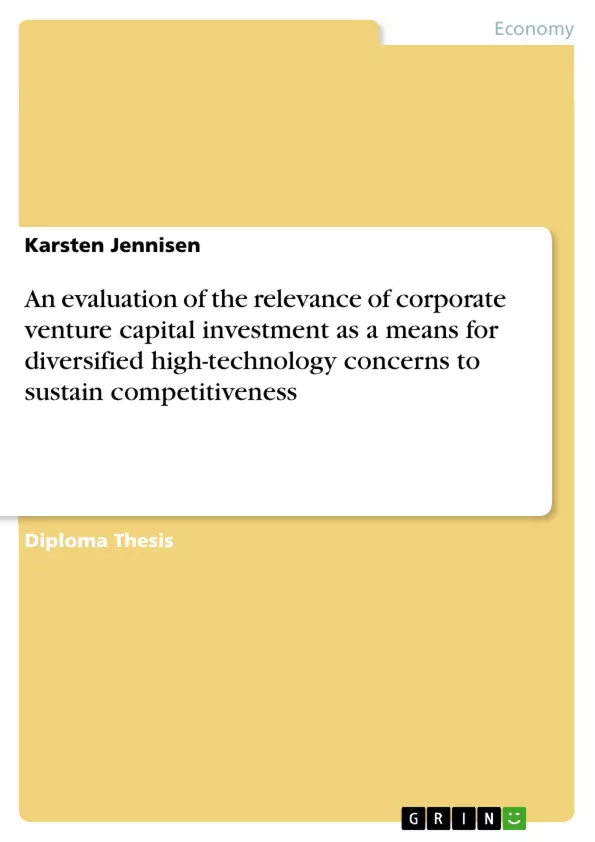Diese Arbeit bewertet, wie Investition in Corporate Venture Capital zur Wettbewerbsfähigkeit von großen Technologiekonzernen beitragen kann. Im ersten Abschnitt setzt der Autor den Rahmen für die Begrifflichkeiten im Kontext von Technologie und Innovation sowie der Firmen im Technologiemarkt. Zusätzlich werden grundlegende Thematiken die Technologiefirmen und deren Markt diskutiert.
Um einen Ansatz zur Bewertung zu bekommen wird im zweiten Kapitel die Thematik der Wettbewerbsfähigkeit von Technologiekonzernen in der aktuellen Marksituation untersucht. Wettbewerbsfähigkeit wird diskutiert und erklärt in dem eine größere Menge an Sekundärliteratur entlang eines Models, das von Feurer und Chaharbaghi entwickelt wurde, herangezogen und verarbeitet wird. Aus dieser Diskussion ergibt sich ein genereller Ansatz in bezug auf die Erhaltung der Wettbewerbsfähigkeit von Technologiekonzernen. Da die Aspekte, die die Wettbewerbsfähigkeit beeinflussen ein breites Spektrum abdecken, macht das zweite Kapitel den größten Anteil der Arbeit aus.
Nachdem ein Ansatz zur Erhaltung der Wettbewerbsfähigkeit entwickelt wurde, wird im dritten und letzten Kapitel untersucht, wie die Bemühungen von Technologiekonzernen zur Erhaltung der Wettbewerbsfähigkeit durch Investition in Corporate Venture Capital unterstützt werden. Generell kann man sagen, daß in den Schlußfolgerungen der Effekt von Corporate Venture Capital nicht verneint wird, aber das Wirkungsspektrum in einen klaren eingegrenzten Rahmen gesetzt wird.
Table of Contents
- A. Introduction and methodology
- B. Basics regarding technology and high technology concerns
- I. Definitions and characteristics of technology and the technology market
- 1. Science and research
- 2. Technology
- 3. Technique
- 4. Types of research
- 5. Innovation
- 6. The concept of core technology
- 7. Technology S-curve and life-cycle
- 8. Technology intensity
- 9. Customers
- 10. Technology companies
- 11. The field of research “management of technology”
- 12. The scope of this paper
- II. Target firms and the high technology market
- 1. Market trends
- 2. Strengths and weaknesses of target firms when compared with other types of technology companies
- a. Weaknesses
- b. Strengths
- 3. Window on technology
- 4. New technologies and new markets
- I. Definitions and characteristics of technology and the technology market
- C. Competitiveness
- I. Customer values
- 1. Real option values for customers
- 2. Competitive values
- II. Shareholder values
- 1. Real option values for shareholders
- 2. Relation of customer and shareholder values
- III. The ability to act and react and the dynamism of the competitive environment
- 1. External organisational structures
- 2. Monopoly effect of innovation
- 3. Innovation and value creating business processes
- a. General issues
- b. Development process
- c. Additional considerations to raise the customer value
- d. Market introduction and diffusion
- 4. Reducing the threat by competitors' technologies
- 5. Dealing with shareholder pressure
- IV. Developing a competitiveness approach for target firms
- 1. Competitive intelligence
- 2. Competitive support and education
- 3. Shareholder communication
- 4. Research
- 5. Capability to focus development
- 6. Organisation structures and culture
- 7. Interdependencies
- 8. Investment levels
- I. Customer values
- D. Corporate venture capital and competitiveness
- I. Basics of corporate venture capital
- 1. Definition and differentiation
- 2. Types and internal organisation of CVC investment
- 3. Characteristics of the investment process
- a. Finding suitable investments
- b. Portfolios
- c. Maintaining investments
- d. Developing investments and divesting
- II. Corporate venture capital investment and sustaining competitiveness
- 1. Potential benefits of corporate venture capital
- 2. Potential problems of corporate venture capital
- 3. How benefits and problems relate to competitive investments
- 4. Conclusions about CVC investment and sustaining competitiveness
- I. Basics of corporate venture capital
Objectives and Key Themes
This dissertation explores the relevance of corporate venture capital (CVC) investment as a strategy for diversified high-technology companies to maintain their competitive edge. It examines the dynamics of the high-technology market, the challenges of sustaining competitiveness, and the potential benefits and drawbacks of CVC investment in this context.- Defining the role of technology and innovation in high-technology markets
- Analyzing the competitive challenges faced by high-technology companies
- Exploring the concept of CVC investment and its potential impact on competitiveness
- Evaluating the benefits and risks associated with CVC investment
- Developing a framework for understanding how CVC can contribute to sustainable competitiveness in high-technology companies
Chapter Summaries
- Chapter A introduces the dissertation's methodology and sets the stage for the research question.
- Chapter B delves into the characteristics of technology and high-technology companies, exploring key concepts like innovation, core technology, and the technology life-cycle. It analyzes the market trends and challenges faced by target firms in the high-technology sector.
- Chapter C examines the multifaceted concept of competitiveness in the context of high-technology companies. It focuses on customer values, shareholder values, and the dynamics of the competitive environment, exploring how companies can adapt to rapid technological change and maintain their position in the market.
- Chapter D focuses on corporate venture capital (CVC) investment, defining its nature and exploring its potential benefits and drawbacks in the context of maintaining competitiveness. It analyzes the investment process and the potential impact of CVC on the sustainability of high-technology companies.
Keywords
This dissertation primarily focuses on the intersection of corporate venture capital, high-technology companies, and the critical factors influencing their competitiveness. Key concepts include innovation, core technology, market dynamics, customer and shareholder values, competitive intelligence, and the ability to adapt to rapid technological change. The study examines the potential of CVC investment as a strategy for sustaining competitiveness in a dynamic and highly competitive environment.- Arbeit zitieren
- Karsten Jennisen (Autor:in), 1999, An evaluation of the relevance of corporate venture capital investment as a means for diversified high-technology concerns to sustain competitiveness, München, GRIN Verlag, https://www.grin.com/document/185631



